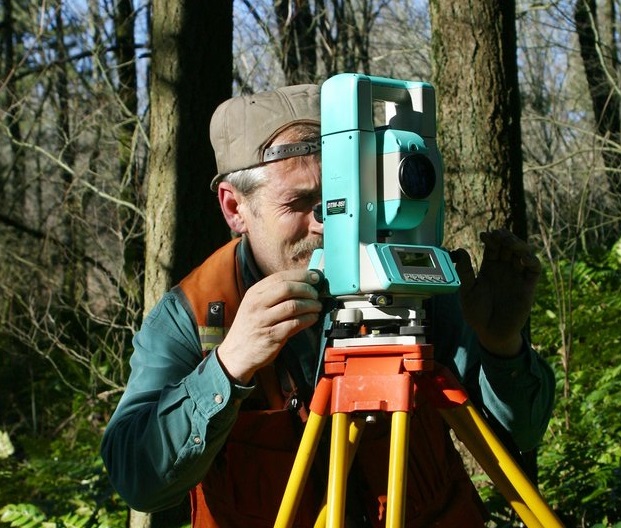
Will you have a survey done before your coming real estate deal? Of course, a professional will be examining the title. But a title search does not include a survey. With a title search, the title company reviews the chain of title, up to the present ownership. It does not reveal specific physical details of the property.
Depending on the region of the country (and even the state) in which the home exists, the mortgage company might or might not require a survey. Nevertheless, either the seller or the buyer may want to hire a service to produce an up-to-date survey. Here, we make the case for having this done — so you can decide for yourself.
What Is a Property Survey?
A property survey is, as the term suggests, a diagram of boundaries, angles, and measurements. It shows where on Earth the real estate is. It precisely sets forth the property’s dimensions. It shows the key structures and features of the real estate, and makes clear where the property owner’s land stops, and the adjacent property owners’ lands begin.
A land survey also lays out the points of access to the property. Surveys can indicate changes by past owners — new structures, additions to the home, new pavement, new fences.
Does a Seller Need a Property Survey?
A seller might wonder if shelling out a few hundred dollars for a property survey is an unnecessary expenditure. Consider the home within a stone wall that runs around the entire property. Or perhaps the property is a unit of a condo community, so the surrounding land is held by the homeowners’ association.
The owner of the walled home might benefit from a survey if, say, the property is bigger than a public listing indicates. For the condo unit, the interior dimensions matter, and the buyer’s appraisal states those. (If the condo is bigger than the listing indicates, the appraisal may say, for example: “Public records state the unit is 1,000 square feet, but based on physical measurements it is 1,100 square feet.”)
For many detached homes, hiring a surveyor can help to ensure a transparent and informative home sale. Proactively taking this step could spare the seller the agony of watching a deal fall though on account of something that could have been remedied in advance, if only the seller had known.
Could the property have some kind of invisible hazard? Examples include:
- Sinkholes. Could the property be vulnerable to sinkholes? Sinkholes do their biggest damage in Alabama, Florida, Kentucky, Missouri, Pennsylvania, Tennessee, and Texas, according to the U.S. Geological Survey.
- Flood risks. Updated surveys may indicate that the property potentially exists in a flood risk zone.
The seller should know what potential damage should be mitigated from the threat of sinkholes, floods, and other hazards, to know the fair market value of the home and the proper disclosures to make.
Does a Buyer Need a Survey?

You’re buying a home, and you know where it is and how much land you’re getting. But do others claim the right to use, place equipment or vehicles upon, or travel over some part of your property? A survey will reveal geographic evidence of those claims. A survey could shed light on easements that weren’t obvious when you toured the property with an agent or took a virtual tour. Perhaps there’s evidence of a hiking pathway that meanders through a back corner of the land. Maybe another property owner has a gate, a fence, or a row of hedges placed inside your future home’s boundaries.
In such cases, the step of hiring a surveyor will pay off. You’ll be equipped to negotiate an appropriate discount on the sale price, or get the current owner to take care of an ongoing issue so you don’t have to.
In any case, as the buyer, you’ll want to know that the fences and trees surrounding the property are in the right places. You’ll need to know where underground utilities exist, where you can dig, and where you’ll place shrubs, fences, your pool, a walkway, or other planned features. You’ll want to examine the survey for any setbacks that keep you from installing anything at the boundary edges.
Will the Mortgage Depend on Getting a Survey Done?
A survey, along with the title report, is a must-have for the lender’s insurance policy. An underwriter may insist on a survey in order to issue lender’s title insurance. Otherwise, the insurance will likely exclude coverage for problems that could have been discovered by the survey.
Yet if the current owner’s survey is of fairly recent vintage, title companies in some states might simply accept a seller’s affidavit as assurance that the property has not changed since the survey was done: no fences repositioned, no new gas lines or sewer pipes placed in the ground, etc. In this case, the title company will recertify the existing survey.
In other cases, a title agent might insist on a more recent survey. This is especially likely if there are uncertain or changeable features: things like meandering creeks, clearings where utility work is done, questionable driveway placement, or a possible right-of-way where others are regularly passing through the property.
If you’re paying cash, you may decide to skip the survey step. Yet there are good reasons, as you can see, for investing in a survey. After all, you’ll be buying the real estate and accepting the deed. With a survey, the whole idea is to ensure the continued accuracy of the legal description on your deed. Being well informed will also help you make the right decisions about the provisions that can benefit you in an owner’s insurance policy.
How Is the Survey Done?
A surveyor goes to the site with current home deed, including the current legal description, and the home’s historical records and maps. The existing legal description was written by a prior surveyor. This prior information enables the surveyor to identify dimensions and borderlines. At the same time, the new survey checks the accuracy of the current legal description. Surveyors also inspect the boundary descriptions of the adjacent properties, to see that various owner’s documents match.
The core of the job entails mapping the property lines and reviewing the metes and bounds in the prior surveyor’s field notes, or, if available, the public survey. Landmarks can change, so the surveyor will actually measure the land, and note where utilities, setbacks, and easements are. A home beside railroad tracks, for example, needs the proper bounds set forth beside the tracks, so this can be written into the legal property description.
Finally, to get the real estate transfer documents ready, a title company reviews the survey, and makes sure there are no discrepancies between the surveyor’s field notes and the existing recorded documents.
Tips for Obtaining Your Survey
Your survey or plat map should be on file with the county recorder of deeds. If you need an updated survey done, check with the prior surveyor. It may be cheaper and easier for this person to retrace the steps done in the previous survey and update it than to start afresh with a new company. Check the existing survey as it will tell you the name of the surveyor. If the surveyor cannot be reached, your real estate agent will likely have a recommendation. You might also look to the chapter of the National Society of Professional Surveyors in your state.
To sum up, having a property survey done is important because:
- A survey is a basic way to understand the physical details of your property.
- Having a survey certified to you as the owner means you are able to use your survey to settle any property border questions.
- A survey protects the integrity of your deed.
If you run into conflicts, consult with a local real estate attorney for experienced advice on how to work out the issues.
Banner photo: Public domain. Photo in text: Bonnie Kittle, via Unsplash.
